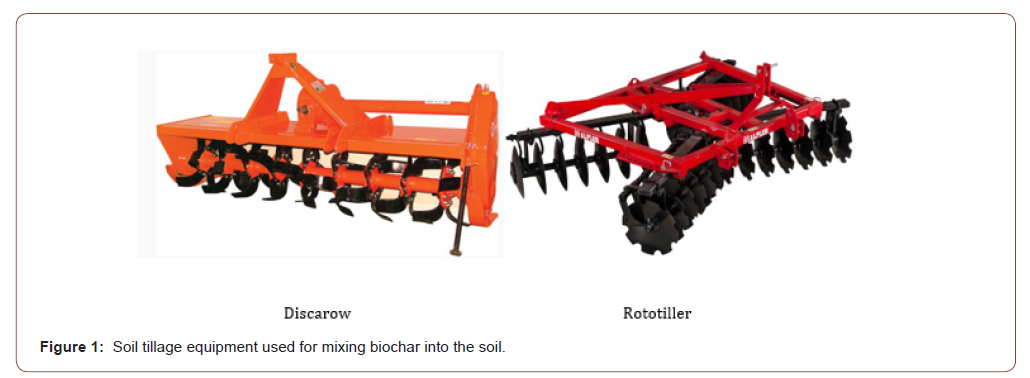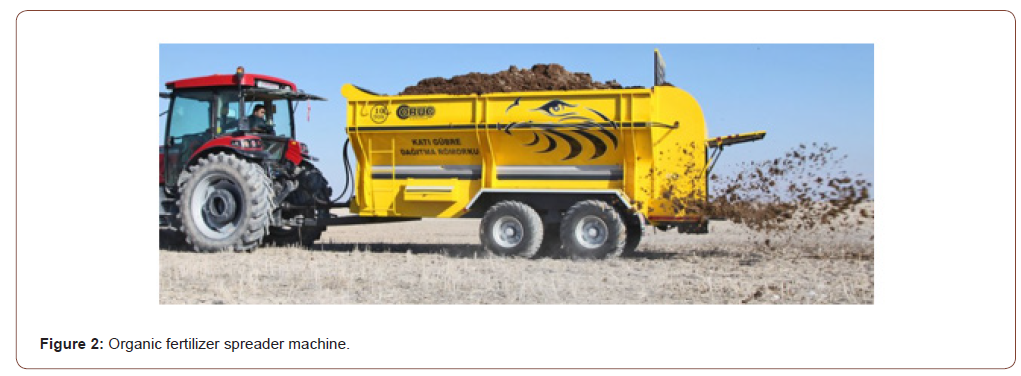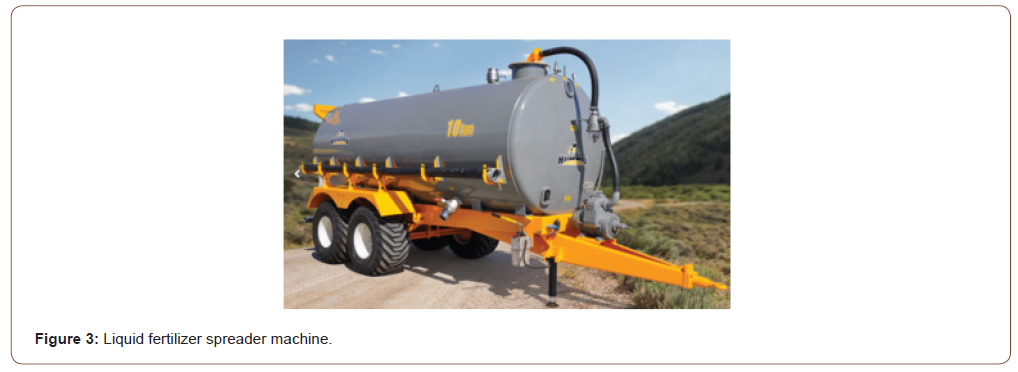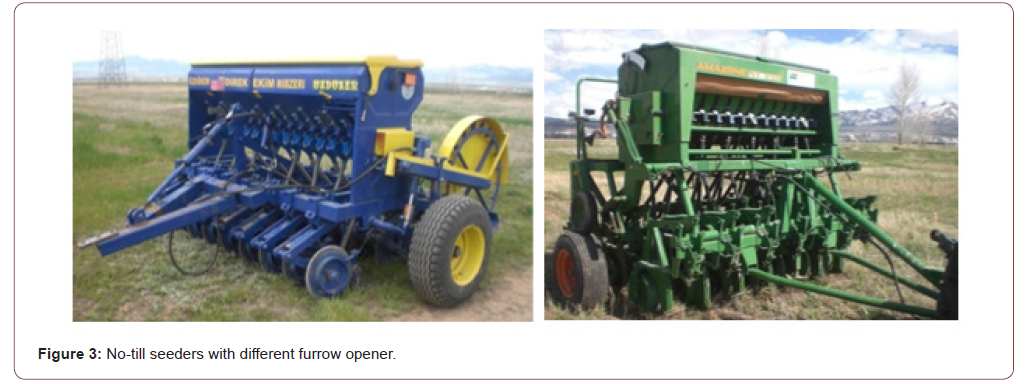 Mini Review
Mini Review
Methods of Application and Incorporation of the Biochar into Soil
Mehmet Hakkı Alma1* and Alperay Altikat2
1Professor, Iğdır University Agricultural Faculty Department of the Biosystems Engineering, Iğdır, Turkey
2Master student, Iğdır University Agricultural Faculty Department of the Biosystems Engineering, Iğdır, Turkey
Mehmet Hakkı ALMA Professor, Iğdır University Agricultural Faculty Department of the Biosystems Engineering, Iğdır, Turkey.
Received Date: April 10, 2021; Published Date: April 30, 2021
Abstract
Biochar from thermochemical transformation processes of biomass is used as a potential soil conditioner for problem soil. Biochar application into the soil cause positive improvement in the physical, chemical and biological soil quality criteria. Biochar causes a decrease in soil bulk density and increase the soil porosity. In addition to this, biochar application increases the soil aggregate stabilization and amount of the water stored in plants. Biochar has positive effects on the carbon content of the soil. Carbon originating from biochar remains in the lower layers of the soil for many years without deteriorating its properties. Biochar reduces CO2 emission from soil to atmosphere and prevents global warming caused by greenhouse gases in atmosphere. It must be mixed into the soil layer using appropriate methods to obtain these benefits from biochar. In order to mix the biochar into the soil substrates homogeneously, the rotovators and discarows are used. In addition, biochar can be mixed with solid or liquid animal manure by use fertilizer spreader machines and into the soil. Thanks to this method, the benefits of biochar increase to the maximum level.
Keywords: Biochar; Incorporation; Soil; Soil quality; Application
Introduction
Biochar is a high carbon content combustion product formed by burning organic material in the oxygen-free or limited oxygen conditions. Although it depends on the production conditions, it contains between 60% and 80% C in its content. Due to this feature, it can be applied into the agricultural soils with low carbon content as a soil conditioner. The effects of biochar on the agricultural lands have examined at the many scientific research. According to the obtained the results, soil carbon content and crop yield [1] values increased at the biochar application. In addition, biochar application reduces the CO2 emission from soil to atmosphere [2]. Generally, biochar application into the soil enhances soil physical, chemical [1,3,4] and biological quality criteria.
The effects of biochar on the soil vary depending on the biochar pyrolysis conditions. The temperature used during thermochemical reactions at the biochar production affects the quality of biochar and naturally the physical properties of the soil. Generally, biochar produced at high temperatures (> 500 °C) has more moisture retention property than produced at low temperatures [1,5,6]. The biochar produced at the high temperatures has more pore area than the produced at the low temperature. Biochar with a pored structure holds more water and it transmits more water to the plant body. In addition, some studies have concluded that pyrolysis temperature is less effective on the soil physical properties compare to the other soil properties [2,7-10].
Another factor that changes the efficiency level of the biochar in the soil is the amount of biochar applied. As the amount of biochar applied increases, positive changes occur in the some of the soil properties. The Biochar mixed into the soil at the large quantities causes a decrease in soil bulk density and an increase at the soil porosity and soil aggregate stability. The water infiltration rate, and the water capacity available in the plant also change in direct proportion to the biochar rate applied into the soil [11]. The aggregate size distribution of the soil is an important factor that allows biochar to be effective on the soil properties. In the researches, the effect of biochar on the soil physical properties was observed more clearly in high-textured soils than in the normaltextured soils [12]. The most important reason for this is that the difference in aggregate size and density between biochar and sand particles is greater than the difference between biochar and clay particles. Small biochar particles can fill large porous structures in sandy soils and thus increase water flow speed compared to clay soils. In addition, biochar particles act as a binding agent with organic structure in sandy soils, increasing the level of soil aggregation. Application of biochar into the soil in the combination with inorganic or organic fertilizers more improves soil properties than applying only biochar into the soil. For example, it has been concluded that if Biochar mixed with animal manure and given into the soil, the soil aggregation level improved more compare to the others application [13]. The reason for this result it creates an unstable and temporary effect at the soil that fertilizer or biochar are applied into the soil, separately. When mix biochar and animal manure the biochar interacts with organic components and creates a binding structure.
A certain period of time is required to determine the effects of biochar on the soil properties. For example, In a study it was stated that the water impermeability is higher in the new biochar application plots compared to the old application [14]. The oxidation and drying of the biochar over time reduces the organic compounds on the surface of the biochar particles and can cause degradation in the water retention tribes. However, the carbon contained in the biochar interacts with organic and inorganic substances of the soil over time, improving the level of aggregation and other physical properties of the soil [14]. As the particle size of biochar directly affects the biochar-soil interaction, it also has an important effect on the soil physical properties. Small biochar particles easily mix with the soil compared to larger biochar particles and interact with the soil [7]. In addition, the smaller the biochar particles, the larger their surface area per unit mass.
Methods Mixing Biochar into the Soil
The benefits of biochar to the soil may vary depending on the method of mixture it into the soil. The studies have shown that mixing biochar with soil improves the physical properties of the soil and reduces wind and water erosion. A few field experiments have been conducted to determine whether laying biochar on the soil surface or mixing it into the soil is a more effective method. In a small number of studies, it has been concluded that mixing biochar into the soil rather than laying it on the soil surface reduces its water resistance [15] and soil bulk density [16]. In a study concluded that biochar applied to the soil surface reduces the albedo (light reflecting property) of the soil [17]. The reduction of soil albedo can be particularly beneficial in temperate climates. The albedo feature of the soil decreases when the biochar is buried directly into the soil. For this purpose, no-tillage systems can use. But the application of this method leads to less improvement in the soil physical properties than the method of mixing biochar into the soil the number of studies investigating the effects of biochar mixing methods into soil and plant development is quite limited.
Biochar can be added by mixing homogeneously into the upper soil layer (at the 15 cm soil depth). For this purpose, firstly, biochar is scattered on the soil surface by hand or machine. The rotovators or disc harrows can be used for mixing biochar into the upper soil layer (Figure 1). Thus; soil physical properties such as bulk density, porosity, water holding capacity and infiltration are improved. However, the important issue in this stage is that biochar does not remain above the soil surface. Biochar dust that is not mixed into the soil is released into the atmosphere through wind erosion and threatens human health. In addition, biochar is washed away during irrigation (especially in traditional irrigation method) and the expected impact on the soil cannot be observed. When it is desired to mix biochar into the deeper soil layer, the plows utilized in the conventional tillage method are used. The biochar laid on the ground can be mixed easily 30-35 cm soil depth with help of a plow.

Biochar can be mixed with organic fertilizers or composts and given into the soil [18,19]. In particular, mixing animal manure and biochar into the soil is an application that increases the effectiveness of biochar. Manure spreader machines are used for this purpose (Figure 2). Biochar mixed with animal manure is laid on the soil by fertilizer spreader machines and mixed into the soil substrate with disc harrows or rotovators. In addition, biochar can be mixed with liquid animal manure and added to the soil surface or sublayers [2,19,20]. For this purpose, liquid animal manure dispensing machines are used (Figure 3).


Deep-Banded Application in the Intra-Rows

Biochar is applied into the intra-rows at the sowing depth [21]. For this purpose, generally no-till seeders are used (Figure 3). In the no-tillage systems, seeds are sown in the field covered with stubble. This method has many advantages such as reducing soil erosion and soil bulk density, increasing the soil electrical conductivity and reducing the amount of CO2 emission from the soil to the atmosphere. Biochar can be added to the seed or fertilizer storages of seeders and can be added in to the soil substrate at the sowing depth (Figure 4).
Conclusion
Today, the soil quality has deteriorated as a result of inorganic fertilizers, unconscious irrigation methods and intensive use of pesticides and insecticides given into the soil for increasing productivity, and the most of the agricultural lands have become unproductive. From this point of view, the use of the optimum production techniques is considered to be a very important issue across the world. Biochar is a high-carbon soil regulator produced by various thermochemical methods from the organic material and can be used in inefficient soil conditions. It has the ability to improve the physical, chemical and biological quality criteria of the soil, especially when used in heavy textured soils. In addition, the carbon content in the soil can be directly increased by the addition of biochar into the soil. The Carbon of biochar origin remains constant for many years without dissolving in the soil. Due to this feature, the biochar improves the soil moisture content, compaction level, aggregate stability and infiltration level of the soil. In addition, they prevent soil contamination by adsorbing herbicides and insecticides used in the production phase. There is also a significant decrease in the level of CO2 emission from the soil to the atmosphere as a result of the addition of biochar into the soil. So, it reduces greenhouse gas emissions in the atmosphere and the global warming is prevented.
Currently, the most of the research on this topic has been carried out either in the laboratory or in the greenhouses. In the large agricultural lands, the experiments that have been going on for many years are almost non-existent. For this reason, a large number of field experiments are needed to determine the true effects of biochar on the soil. The success of this experiments to be done depends on mixing biochar into the soil using appropriate methods. Biochar, which cannot be mixed into the desired soil depth, may be harmful to the environment and human health, and may cause fires, especially in temperature regions. The rotavators are one of the effective tillage tools that can mix biochar into the soil depths. Different mixing levels can be achieved by varying the rotor rotational speed of these machines. The no-till seeder is a suitable machinery when biochar burying into the soil at the sowing depth. Because these machines are designed to work in untreated soil conditions, they can bury biochar into the soil at the sowing depth.
Acknowledgement:
None.
Conflict of Interest:
No conflict of interest.
References
- Brassard P, G Stephane, R Vijaya (2016) Soil biochar amendment as a climate change mitigation tool: Key parameters and mechanisms involved. J Environ Manage 181: 484-497.
- Lehmann J, MC Rillig, J Thies, CA Masiello, WC Hockaday, et al. (2011) Biochar effects on soil biota: A review. Soil Biol Biochem 41: 1812-1816.
- Ding Y, YG Liu, SB Liu, ZW Li, XF Tan, et al. (2016) Biochar to improve soil fertility: A review. Agron Sustain Dev 16: 16.
- Mukherjee A, R Lal, AR Zimmerman (2014) Impacts of 1.5-year field aging on biochar, humic acid, and water treatment residual amended soil. Soil Sci 179: 111-119.
- Kinney TJ, CA Masiello, B Dugan, WC Hockaday, MR Dean, et al. (2012) Hydrologic properties of biochars produced at different temperatures. Biomass Bioenergy 41:14-41.
- Gray M, MG Johnson, MI Dragila, M Kleber (2014) Water uptake in biochars: The roles of porosity and hydrophobicity. Biomass Bioenergy 61:196-205.
- Herath HMSK, MC Arbestain, M Hedley (2011) Effect of biochar on soil physical properties in two contrasting soils: An alfisol and an andisol. Geoderma 209-210: 188-197.
- Andrenelli M, A Maienza, L Genesio, F Miglietta, S Pellegrini, et al. (2016) Field application of pelletized biochar: Short term effect on the hydrological properties of a silty clay loam soil. Agric. Water Manage 161: 190- 196.
- Burrell LD, F Zehetner, N Rampazzo, B Wimmer, G Soja (2016) Longterm effects of biochar on soil physical properties. Geoderma 282: 96-102.
- Esmaeelnejad L, M Shorafa, M Gorji, SM Hosseini (2016) Enhancement of physical and hydrological properties of a sandy loam soil via application of different biochar particle sizes during incubation period. Span J Agric Res 14(2): e1101.
- Rogovska N, DA Laird, DL Karlen (2016) Corn and soil response to biochar application and stover harvest. Field Crops Res 187: 96-106.
- Omondi MO, X Xia, A Nahayo, X Liu, PK Korai, et al. (2016) Quantification of biochar effects on soil hydrological properties using meta-analysis of literatüre data. Geoderma 274: 28-14.
- Khademalrasoul A, M Naveed, G Heckrath, KGID Kumari, LW Jonge, et al. (2014) Biochar effects on soil aggregate properties under no-till maize. Soil Sci 179: 271-281.
- Briggs C, JM Breiner, RC Graham (2012) Physical and chemical properties of Pinus ponderosa charcoal: Implications for soil modification. Soil Sci 177:261- 268.
- Page-Dumroese D, PR Robichaud, RE Brown, JM Tirocke (2015) Water repellency of two forest soils after biochar addition. Trans ASABE 58: 115-142.
- Usowicz B, J Lipiec, M Lukowski, W Marczewski, J Usowicz (2016) The effect of biochar application on thermal properties and albedo of loess soil under grassland and fallow. Soil Tillage Res 164: 45-51.
- Verheijen FG, S Jeffery, M van der Velde, V Penižek, M Beland, et al. (2011) Reductions in soil surface albedo a s a function of biochar application rate: Implications for global radiative forcing. Environ Res Lett 8: 044008.
- Yoshizawa S, Tanaka S, Ohata M (2007) Proliferation effect of aerobic micro-organisms during composting of rice bran by addition of biomass charcoal. in Proceedings of the International Agrichar Conference, Terrigal NSW, Australia, May 2007, p26.
- Kleegberg KK, Schlegelmilch M, Strees J, Steinhart H, Stegmann R (2005) Odour abatement strategy for a sustainable odour management. in Proceedings of the Tenth International Waste Management and Landfill Symposium, Sardinia.
- Scotford IM, Cumby TR, Inskip PF (2001) Improving the control and accuracy of slurry spreaders. Journal of Agricultural Engineering Research 79: 119-149.
- Blackwell P, Shea S, Storer P, Solaiman Z, Kerkmans M, et al. (2007) Improving wheat production with deep banded oil mallee charcoal in Western Australia. in Proceedings of the International Agrichar Conference, Terrigal, NSW Australia.
-
Mehmet Hakkı Alma, Alperay Altikat. Methods of Application and Incorporation of the Biochar into Soil. World J Agri & Soil Sci. 7(1): 2021. WJASS.MS.ID.000653.
-
Biochar, Incorporation, Soil, Soil quality, Application
-

This work is licensed under a Creative Commons Attribution-NonCommercial 4.0 International License.






